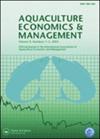Characteristics of early adoption and non-adoption of alternative catfish production technologies in the U.S.
IF 3.8
2区 经济学
Q1 AGRICULTURAL ECONOMICS & POLICY
引用次数: 26
Abstract
Abstract U.S. catfish producers have been exploring the adoption of alternative-production technologies (intensive-aeration, in-pond raceways, and split-pond systems) in recent years for achieving cost efficiencies. A multi-state (Alabama, Arkansas, and Mississippi) survey was conducted to identify specific reasons influencing the decisions of producers whether or not to adopt these alternative catfish production technologies. High yield and greater control over the production process were the major reasons for the adoption of alternative catfish production technologies. High investment costs and increased risks associated with these technologies were the main reasons for not adopting new technologies. Early adopters had significantly larger farms, greater numbers of ponds, and a significantly greater percentage of use of hybrid catfish. Econometric analysis suggested that characteristics of the technology such as productivity, perceived risk, and adoption costs, influenced early adoption decisions. Institutional factors such as prior involvement in Extension/research programs and farm characteristics of the scale of operation also shaped adoption decisions. Understanding the characteristics (of the technology, farms, and producers) that lead to greater adoption, may provide guidance to increase the rate of successful transfer of new technologies to fish producers.美国早期采用和未采用替代鲶鱼生产技术的特点。
摘要近年来,美国鲶鱼生产商一直在探索采用替代生产技术(强化曝气、池内滚道和分流池系统),以实现成本效益。进行了一项多州(阿拉巴马州、阿肯色州和密西西比州)调查,以确定影响生产者决定是否采用这些替代鲶鱼生产技术的具体原因。高产率和对生产过程的更大控制是采用替代鲶鱼生产技术的主要原因。与这些技术相关的高投资成本和风险增加是不采用新技术的主要原因。早期采用者拥有更大的农场、更多的池塘,杂交鲶鱼的使用比例也更高。计量经济学分析表明,生产率、感知风险和采用成本等技术特征会影响早期的采用决策。诸如先前参与推广/研究项目和农场经营规模特征等制度因素也影响了收养决定。了解导致更多采用的(技术、农场和生产者)特征,可以为提高向鱼类生产者成功转让新技术的比率提供指导。
本文章由计算机程序翻译,如有差异,请以英文原文为准。
求助全文
约1分钟内获得全文
求助全文
来源期刊

Aquaculture Economics & Management
FISHERIES-
CiteScore
7.30
自引率
17.90%
发文量
21
期刊介绍:
Aquaculture Economics and Management is a peer-reviewed, international journal which aims to encourage the application of economic analysis to the management, modeling, and planning of aquaculture in public and private sectors. The journal publishes original, high quality papers related to all aspects of aquaculture economics and management including aquaculture production and farm management, innovation and technology adoption, processing and distribution, marketing, consumer behavior and pricing, international trade, policy analysis, and the role of aquaculture in food security, livelihoods, and environmental management. Papers are peer reviewed and evaluated for their scientific merits and contributions.
 求助内容:
求助内容: 应助结果提醒方式:
应助结果提醒方式:


